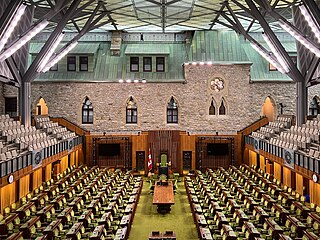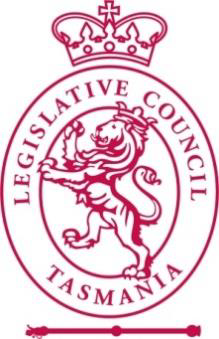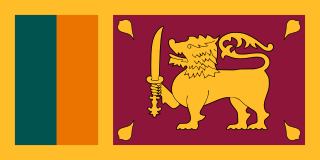| President of the Western Australian Legislative Council | |
|---|---|
since 25 May 2021 | |
| Style | The Honourable Mr / Madam President (in the Council) |
| Appointer | The Monarch's representative at the behest of the Legislative Council |
| Term length | Elected at start of each Parliament |
| Inaugural holder | Sir Thomas Cockburn-Campbell |
| Formation | 29 December 1890 |
| Website | www.parliament.wa.gov.au |
The President of the Western Australian Legislative Council, also known as the Presiding Officer of the Council, is the presiding officer of the Western Australian Legislative Council, the upper house of the Parliament of Western Australia. The position is analogous to that of the President of the Australian Senate.
The President is always a Member of the Western Australian Legislative Council, and is the ceremonial head of that Council. The President therefore performs ceremonial duties, and represents the Council to other organisations. In conjunction with the Speaker of the Western Australian Legislative Assembly, the President is responsible for the administration of the Western Australian Parliament. When the Council is sitting, the President enforces procedures, maintains order, puts questions after debate and ensures each member of the chamber gets a fair opportunity to speak to matters under debate. The President also makes decisions and formal rulings with regards to the chamber's standing orders.
The President of the Legislative Council is elected by the other members of the Council in accordance with Section 49 of the Constitution Act 1889. They must be elected after each general election or upon the death, resignation or removal of a previous President, and can be brought down by a vote of the chamber's members (although this has never happened in Western Australia), so must maintain the confidence of the chamber.
| Order | President | Party (if applicable) | Term begin | Term end | Term in office | Notes |
|---|---|---|---|---|---|---|
| 1 | Sir Thomas Cockburn-Campbell | N/A | 29 December 1890 | 27 September 1892 | 1 year, 273 days | |
| 2 | Sir George Shenton | N/A | 11 October 1892 | 21 May 1906 | 13 years, 222 days | |
| 3 | Sir Henry Briggs | Independent | 21 June 1906 | 8 June 1919 | 12 years, 352 days | |
| 4 | Sir Walter Kingsmill | Independent | 31 July 1919 | 21 May 1922 | 2 years, 294 days | |
| 5 | Sir Edward Wittenoom | Nationalist | 27 July 1922 | 9 August 1926 | 4 years, 43 days | |
| 6 | Sir John Kirwan | Independent | 10 August 1926 | 21 May 1946 | 19 years, 284 days | |
| 7 | James Cornell | Liberal | 25 July 1946 | 25 November 1946 | 123 days | |
| 8 | Sir Harold Seddon | Liberal | 26 November 1946 | 21 May 1954 | 7 years, 176 days | |
| 9 | Anthony Loton | Country | 14 June 1954 | 6 August 1958 | 4 years, 53 days | |
| 10 | Sir Charles Latham | Country | 7 August 1958 | 21 May 1960 | 1 year, 288 days | |
| 11 | Sir Leslie Diver | Country | 28 July 1960 | 21 May 1974 | 13 years, 297 days | |
| 12 | Sir Arthur Griffith | Liberal | 22 May 1974 | 21 May 1977 | 2 years, 364 days | |
| 13 | Clive Edward Griffiths | Liberal | 24 May 1977 | 21 May 1997 | 19 years, 362 days | |
| 14 | George Cash | Liberal | 27 May 1997 | 21 May 2001 | 3 years, 359 days | |
| 15 | John Cowdell | Labor | 22 May 2001 | 21 May 2005 | 3 years, 364 days | |
| 16 | Nick Griffiths | Labor | 24 May 2005 | 21 May 2009 | 3 years, 362 days | |
| 17 | Barry House | Liberal | 22 May 2009 | 21 May 2017 | 7 years, 364 days | |
| 18 | Kate Doust | Labor | 23 May 2017 | 21 May 2021 | 3 years, 363 days | |
| 19 | Alanna Clohesy | Labor | 25 May 2021 | present | 3 years, 182 days |

The House of Commons of Canada is the lower house of the Parliament of Canada. Together with the Crown and the Senate of Canada, they comprise the bicameral legislature of Canada.

President of the Senate is a title often given to the presiding officer of a senate. It corresponds to the speaker in some other assemblies.

The president of the Senate is the presiding officer of the Australian Senate, the upper house of the Parliament of Australia. The counterpart in the lower house is the speaker of the House of Representatives. The office of the presidency of the senate was established in 1901 by section 17 of the Constitution of Australia. The primary responsibilities of the office is to oversee senate debates, determine which senators may speak, maintain order and the parliamentary code of conduct during sessions and uphold all rules and orders of the senate. The current president is Sue Lines, who was elected on 26 July 2022.

The speaker of a deliberative assembly, especially a legislative body, is its presiding officer, or the chair. The title was first used in 1377 in England.

The Victorian Legislative Assembly is the state lower house of the bicameral Parliament of Victoria in Australia; the state upper house being the Victorian Legislative Council. Both houses sit at Parliament House in Spring Street, Melbourne. The main colour used for the upholstery and carpets furnishing the Chamber of the Legislative Assembly is green.

The Parliament of the Democratic Socialist Republic of Sri Lanka is the supreme legislative body of Sri Lanka. It alone possesses legislative supremacy and thereby ultimate power over all other political bodies in the island. It is modeled after the British Parliament. The 17th Parliament of Sri Lanka will convene for the first time on 21 November 2024.

The New South Wales Legislative Council, often referred to as the upper house, is one of the two chambers of the parliament of the Australian state of New South Wales. Along with the Legislative Assembly, it sits at Parliament House in the state capital, Sydney. It is normal for legislation to be first deliberated on and passed by the Legislative Assembly before being considered by the Legislative Council, which acts in the main as a house of review.

The Tasmanian Legislative Council is the upper house of the Parliament of Tasmania in Australia. It is one of the two chambers of the Parliament, the other being the House of Assembly. Both houses sit in Parliament House in the state capital, Hobart. Members of the Legislative Council are often referred to as MLCs.

The Parliament of Victoria is the bicameral legislature of the Australian state of Victoria that follows a Westminster-derived parliamentary system. It consists of the King, represented by the governor of Victoria, the Legislative Assembly and the Legislative Council. It has a fused executive drawn from members of both chambers. The parliament meets at Parliament House in the state capital Melbourne. The current Parliament was elected on 26 November 2022, sworn in on 20 December 2022 and is the 60th parliament in Victoria.

The Parliament of Queensland is the legislature of the Australian State of Queensland. As provided under the Constitution of Queensland, the Parliament consists of the King, represented by the governor, and the Legislative Assembly. It has been the only unicameral state legislature in the country since the upper chamber, the Legislative Council, was abolished in 1922. The Legislative Assembly sits in Parliament House in the state capital, Brisbane.

The National Assembly is the bicameral legislature of the nation of Belize. It is divided into the House of Representatives, with 31 members, elected by universal suffrage, and the Senate, with 13 members, appointed by the Governor-General in consultation with the Prime Minister and the Leader of the Opposition. The presiding officer of the House is the Speaker, while the Senate is presided over by the President.

The Parliament of The Bahamas is the bicameral national parliament of the Commonwealth of The Bahamas. The parliament is formally made up of the sovereign, an appointed Senate, and an elected House of Assembly. It currently sits at the Bahamian Parliament Building in Nassau, the national capital.

The President of the Victorian Legislative Council, also known as the presiding officer of the council, is the presiding officer of the Victorian Legislative Council, the upper house of the Parliament of Victoria and equivalent to the President of the Australian Senate. When there is a vacancy in the office of president, a new president is elected by the members of the council from among its number. The president ceases to hold that office if they cease to be a member of the council, and can be removed at any time by a vote of the members. The current president is Shaun Leane.

The speaker of the Legislative Assembly of Queensland is elected by the members of the Queensland Legislative Assembly to preside over sittings of the Assembly and to maintain orderly proceedings. The Speaker must be a member of the Legislative Assembly. The position is currently held by Curtis Pitt, a former Treasurer of Queensland who was elected to the post on 13 February 2018.

The Speaker of the New South Wales Legislative Assembly is the presiding officer of the Legislative Assembly, New South Wales's lower chamber of Parliament. The current Speaker is Greg Piper, who was elected on 9 May 2023.

The Speaker of the Parliament of the Democratic Socialist Republic of Sri Lanka is the presiding officer of the chamber. The Speaker fulfills a number of important functions in relation to the operation of the House, which is based upon the British Westminster parliamentary system. The speaker is second in the Sri Lankan presidential line of succession, after the prime minister.
The Speaker of the Western Australian Legislative Assembly is the presiding officer in the Legislative Assembly. The office has existed since the creation of the Legislative Assembly in 1890 under the Constitution Act 1889. The 31st and current Speaker is Labor MLA Michelle Roberts, who has held the role since the 2021 state election.
The President of the Queensland Legislative Council, also known as the Presiding Officer of the Council, was the presiding officer of the Queensland Legislative Council, the upper house of the Parliament of Queensland from 1860 until 1922 and analogous to the President of the Australian Senate.
The President of the New South Wales Legislative Council is the presiding officer of the upper house of the Parliament of New South Wales, the Legislative Council. The presiding officer of the lower house is the speaker of the Legislative Assembly. The role of President has generally been a partisan office, filled by the governing party of the time. As of May 2023, the president is Ben Franklin.

The Sarawak State Legislative Assembly is the legislative chamber of the unicameral legislature of the Malaysian state of Sarawak; the Yang di-Pertua Negeri of Sarawak forms the other part of the legislature. The Assembly is modelled after the traditions of the Westminster parliamentary system, which originates from the practices of the British Parliament. The executive branch of government is drawn from the elected members of the Assembly. The State Legislative Assembly sits at the Sarawak State Legislative Assembly Building located in Petra Jaya in Kuching, the state capital.